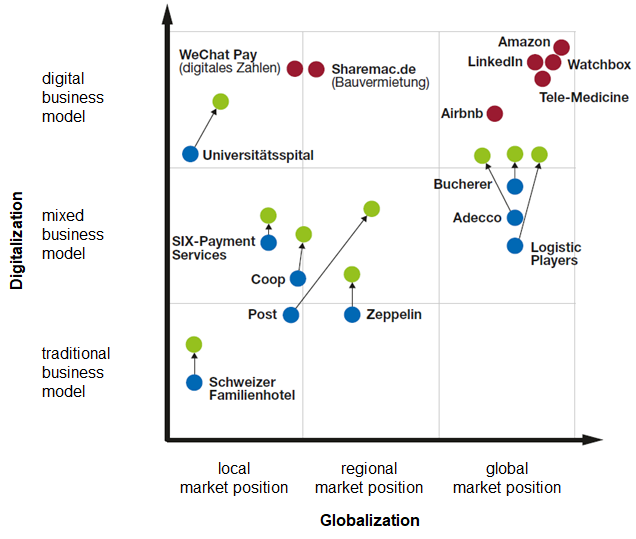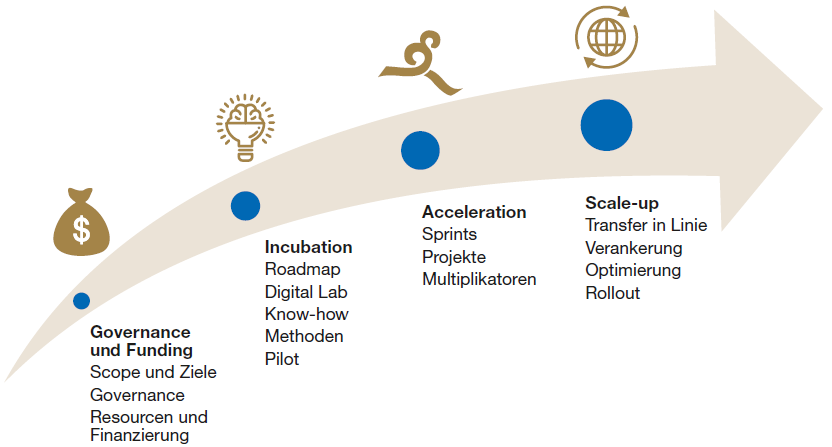I´ve read and heard a lot of times in the last few months: The pandemic has accelerated digitization. The examples then given in this context may all be correct. I ask myself the question: Are these examples just born out of necessity, or is there a strategic concept behind them?
Looking back a little further – Dotcoms, New Economy, etc. – the establishment of the Internet and the mobile phone as well as the development of handheld computers at the end of the last century led to a mood of optimism in the field of digital technology. Classic strategy patterns worked well in markets that were not saturated at the time. So-called inside-out considerations were the rule; BSC, McKinsey and Ansoff matrices were part of every corporate strategy. Companies had growth potential (“stars”) and the “cash cows” were still to be milked.
However, this has already begun to change fundamentally for a number of years. “Question marks” and vague visions dominate more and more often. We also encounter saturated markets in many places. So-called outside-in considerations are advantageous for this, as they support companies in thinking beyond the existing business and promoting creativity.
The first strategic concepts that are helpful for such considerations have already passed their 20th birthday; e.g. Competitive Nightmare (Montante, 1991; Gordon, 2002) and Judo Strategy (Yoffie, Kwak, 2001). More were added later; e.g. Business Model Generation (Osterwalder, 2010), Kill Your Company (Kirsh, 2012), Blue Ocean Strategy (Kim, Mauborgne, 2015) and Innovator’s Dilemma (Christensen, 2016).
So that this post does not become too extensive, I would like to focus on three main areas:
- Basic considerations for digital business transformation,
- The 4 steps of a Nightmare Competitor approach, and
- Execution of digital business models.
Basic considerations for digital business transformation
As already indicated, evolutionary business model developments and change management based on them are often no longer sufficient to ensure sustainable success. Instead, we fundamentally question business models, act disruptively and initiate transformation management programs. Transformation is not just another term for change! Transformation management aims to reinvent a company or a business model. It’s more unpredictable, iterative, and experimental, and therefore involves far more risk than change management initiatives.
The digital business transformation matrix supports companies that deal systematically with change and transformation management. Bergamin/Braun/Glaus examined nine Swiss companies from different industries along this matrix: current positioning (blue), development paths (green) and possible nightmare competitors (red, more on this in a moment):
The authors summarized their findings in eight key points based on the following key questions and “underlined” them with a toolbox:
- Do we have a digital transformation awareness? (Transparency, SWOT, Digital Radar, Hyperawareness)
- Do we follow customer behaviour from the real to the digital space? (Customers, digital channels)
- Are we using the entire spectrum of digital technologies? (Digitization of processes, BI, AI/ML)
- Do we have a digital vision and strategy? (Key questions, roadmap, disruption/nightmare competitors, make or join)
- How do we design our digital business model? (Sharing or platform business models, cooperation between offline and online businesses)
- Does our leadership model fit our digital business model? (traditional/agile forms of organization, core processes, innovation)
- How do we achieve a digital culture? (Efficiency/willingness to perform, mindset shift, culture of openness, willingness to take risks and serendipity, digital readiness)
- How do we manage the digital business transformation? (Innovator or implementer, change management and/or transformation management, success factors)
Nightmare Competitors – marked in red in the graphic above – have consistently developed and implemented their digital business models from the customer’s perspective. In this way, you challenge traditional market leaders. The Nightmare Competitors often have the advantage that they can attack a high-margin product segment with pinpoint accuracy without having to take account of existing customers and legacy systems.
The 4 steps of a Nightmare Competitor approach
Basically, a Nightmare Competitor first analyzes the customers addressed by the established providers and uses specific solutions to target those customer groups that are not perfectly served by the existing providers. In contrast to the Business Model Canvas and the Blue Ocean Strategy, the customer is “outside the equation”, i.e. not an integral part of the business model. With the Nightmare Competitor approach, the business model must serve the customer (customer-centric business model)! Following this approach, Grothe & Lock distinguish five types, so-called archetypes, of Nightmare Competitors based on their experience and apply the procedural steps of the approach with the help of a Business Model Radar in several companies and different industries:
- Describe the established customer base.
- Describe the business model of the established ones.
- Identify underperforming customers.
- Design a model specifically for this customer(s).
There are many ways to get to a different business model. With the help of Business Model Constituents – part of step 2 -, such as the range of services, suppliers and income model, or the canvas modules, you can check whether the most important components of a business model have been taken into account.
At the end of the day, the Nightmare Competitor approach is nothing more than a consciously projected “sense of urgency”! Sometimes this “kick” is necessary in order to take big steps, i.e. to fundamentally question the business model. Numerous insurers are currently doing this with a view to InsurTechs.
Implementation of digital business models
If this has succeeded, i.e. the established and the Nightmare Competitor model is transparently mapped in the Business Model Radar – including problem/solution-fit and product/market-fit – the implementation begins. This follows the 4DX methodology with six implementation steps:
- The design of the implementation, includes governance and funding; i.e. the focus on specific customer needs and the essential goals of the digital business transformation are defined and suitable for implementing the digital strategy.
- When the top management levels are involved, the strategy is translated into fields of action and prioritized according to value (including willingness to pay) and time. The appropriate resources are provided, the financing is secured, there is clarity – also with regard to production and partners (value delivery).
- The involvement of all managers represents the incubation phase. This is where the projects are classified for the suitability of a classic approach (clearly specifiable results) or agile principles (iterative scaling). The need for digital methods (design thinking, scrum, etc.), know-how, technologies and infrastructure (innovation labs, incubators, partners, etc.) has been identified. A roadmap for the innovation projects has been created. The roles and responsibilities in the project are defined, and the interfaces between the project organization and the line organization have been clarified.
- The aforementioned content is finally coordinated and agreed with all parties involved in a so-called team launch. This also includes what the success of the business model actually looks like and how it can be measured (scaling & KPIs).
- The 4DX implementation represents the acceleration phase with a view to digital programs and projects. The progress and the impact are tracked and controlled by means of scoreboards, and the project portfolio is continuously adjusted.
- The rollout of the results of the digital projects and programs throughout the organization is decided at management conferences. The know-how and the transfer of results to the line are ensured and the results are anchored in the culture.
The approach of the BMI Lab, which I presented at the beginning of June, fits in well – shown in green. With each step, the uncertainty is reduced, the company learns, adapts the business model and ultimately decides at each step whether it is worth pursuing the idea or not.
The authors Bergamin/Braun/Glaus already cited above summarize four focal points (shown in blue) of the implementation in the following graphic:
Conclusion
I consider the following lessons learned to be important in the course of a digital business transformation from a strategic perspective:
- Strategic methods and procedures have continuously evolved. In order to use the potential of digitization, you should also include those for outside-in considerations – always depending on the respective company context.
- The cultural and organizational-technical prerequisites are decisive: knowledge of digital technologies and customer trends, setting up agile organizations and developing disruptive business models.
- Digital business models must consistently be conceived from the customer – their problems and needs. Create personas.
- Remember: online and offline presence is often not an either-or, but rather a both-and.
- Digitization has the potential to challenge traditional industrial sectors.
- Evaluate “make-or-join” strategies, because investments in the digital transformation of an analog business model are enormous.
- Small niche providers with global reach can also be successful on the international stage thanks to their core competencies. Digital platform solutions in particular offer new potential here.
- The development of digital business models takes place under great uncertainty, rely on data and facts instead of opinions to reduce them.
- Make quick decisions, act bravely, don’t wait for the 100 percent solution, cancel unnecessary meetings and give resilient talents a chance.
- Forget about “one size fits all”; instead, “the winner takes it all” applies.
How do you experience the digital business transformation? What experiences would you like to share with the readers of this article? Simply write a comment or ask for information about a 2.5-day workshop.




Leave A Comment